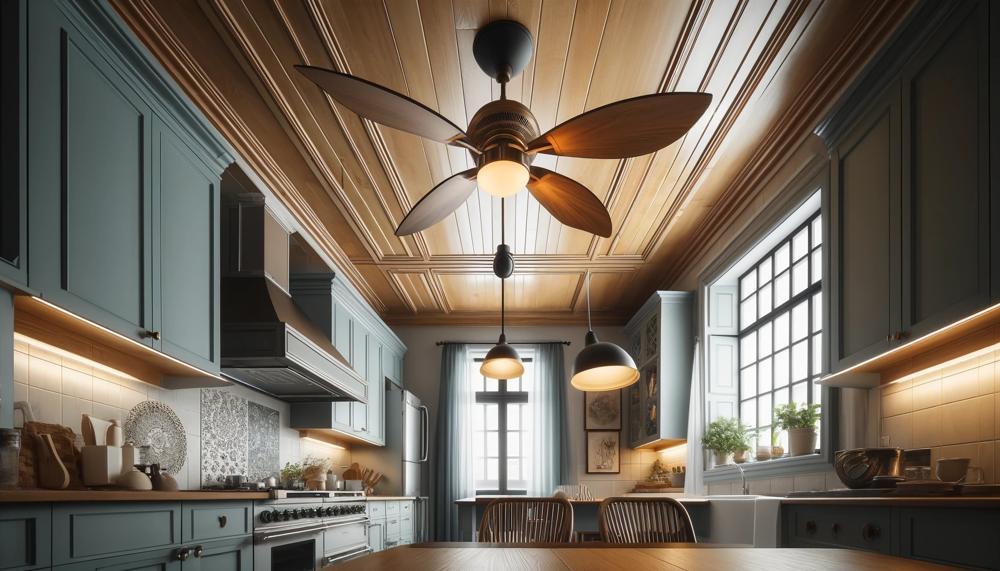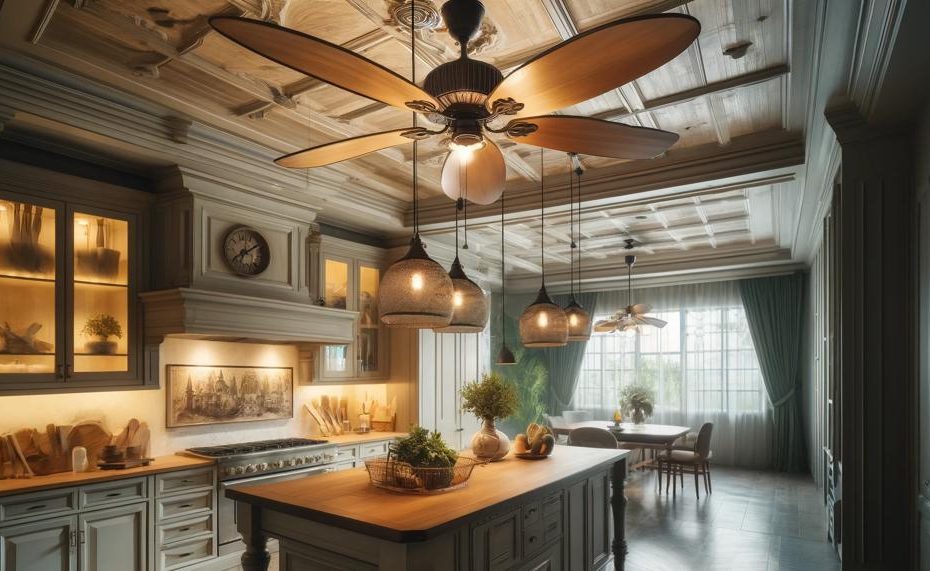Embarking on a culinary adventure in the comfort of your own kitchen goes beyond just the ingredients and recipes; it’s about creating an environment that complements the art of cooking.
Among the myriad considerations for kitchen design, the question of incorporating ceiling fans often surfaces, stirring a mix of opinions and preferences.
This blog post delves into the heart of this debate, slicing through the common misconceptions to serve you the real scoop on whether ceiling fans deserve a spot in your kitchen.
So, can I Use ceiling fans in kitchen?
Yes, ceiling fans can be useful in kitchens. They can improve air circulation, which can help with cooking odors, heat buildup, and steam. Ceiling fans can also help save energy costs.
So, let’s get started.
Contents
Reasons To Put A Ceiling Fan In Your Kitchen
| Improved Air Circulation | Whisks away heat and steam from cooking, making the kitchen airier and more pleasant. |
| Enhanced Ventilation | Helps reduce carbon monoxide buildup from gas stoves by circulating fresh air, crucial in smaller kitchens with limited ventilation. |
| Odour Reduction | Dispels cooking odours, keeping your kitchen smelling fresher. |
| Aesthetic Appeal | Available in various styles to complement any kitchen décor, adding a touch of elegance and providing ambient lighting if equipped with light kits. |
| Cost-effective Update | An affordable way to refresh the kitchen’s look without extensive renovations, with the potential for DIY installation. |
| Energy Efficiency | Reduces the need for air conditioning, cutting down on energy bills and promoting environmental sustainability. |
Choosing the right ceiling fan for your kitchen involves selecting one that’s damp or wet rated to handle the environment’s moisture and grease. Strategic placement ensures optimal air flow and cooling effects.
Benefits Of A Ceiling Fan In The Kitchen
The presence of a ceiling fan in the kitchen can be a real game-changer, offering multiple advantages that go beyond mere aesthetics. Let’s delve into these benefits, equipped with insights to make your kitchen a more efficient and inviting space:
Improved Air Circulation and Ventilation:
A ceiling fan in the kitchen is like a breath of fresh air, literally. Especially in kitchens lacking windows or adequate ventilation, it becomes a vital component for maintaining air flow.
This is not just about comfort; it’s about creating an environment where you’re not battling against the steam and stuffiness that cooking can bring.
Heat and Steam Dissipation:
Cooking can turn your kitchen into a mini sauna. The fan helps in whisking away heat and steam, ensuring you’re not stewing in your own kitchen.
It’s not just about comfort; this has health implications too, preventing issues caused by excessive heat and humidity.
Odor Reduction:
Let’s face it, as much as we adore garlic and onions, their aroma lingering for hours can be less than ideal. A ceiling fan steps in here, circulating air and sending strong cooking odors packing.
Energy Efficiency:
Talking about being penny-wise, a ceiling fan in the kitchen can save you some coins. It allows less reliance on air conditioning, and when used in tandem, you can up your thermostat a tad, leading to lower electricity bills.
Aesthetic Appeal:
A ceiling fan can be the cherry on top of your kitchen décor. With a multitude of designs available, it’s not just a functional appliance but a style statement.
Source of Light:
Many ceiling fans come with or have options for lighting fixtures, providing a dual function in kitchens where lighting is inadequate.
Easy Installation and Maintenance:
Unlike some fancy kitchen gadgets, ceiling fans don’t demand complex installation or high maintenance. They’re user-friendly in the truest sense.
Adds Value to Your Home:
A well-installed ceiling fan is a nod to practicality and efficiency, something that potential buyers often appreciate.
Types of Kitchen Ceiling Fans
Ceiling fans are more than just appliances for stirring the air; they are pieces of craftsmanship that blend functionality with style, especially in the heart of the home – the kitchen.
To keep your culinary space breezy and fresh, consider the following types of ceiling fans, each tailored for the unique demands of a kitchen environment.
| Type | Features | Suitable For |
| High-performance Ceiling Fans | Robust motor, larger blade span | Kitchens with high heat and humidity levels |
| Damp-rated Ceiling Fans | Moisture-resistant coating | Areas with steam and moisture from cooking |
| Outdoor Ceiling Fans | Weather-resistant construction | Kitchens needing durable air circulation solutions |
| Remote-controlled Ceiling Fans | Convenient control, adjustable settings | Busy kitchens where ease of use is a priority |
| Flush-mount Ceiling Fans | Low profile, mounted close to the ceiling | Kitchens with low ceilings to maximize space |
| Lighted Ceiling Fans | Integrated lighting for additional illumination | Kitchens requiring both ventilation and lighting |
Choosing the perfect ceiling fan for your kitchen isn’t just about moving air; it’s about creating an ambiance that complements your lifestyle and décor.
Whether you’re whipping up a storm or enjoying a quiet cup of tea, the right fan can transform your kitchen into a haven of comfort and style.
Consider your kitchen’s size, ceiling height, and aesthetic when selecting a fan.
Things To Consider While Installing A Kitchen Ceiling Fan
When it comes to installing a ceiling fan in the kitchen, it’s not just about aesthetics or air circulation. Safety must be your paramount concern.
Here’s a detailed guide to help ensure your kitchen remains a safe haven, even with the new addition.
Proper Installation and Secure Mounting
The foundation of ceiling fan safety is ensuring it’s installed securely. This means adhering strictly to the manufacturer’s guidelines and using the correct tools and hardware. For peace of mind and professionalism, having a certified electrician perform the installation is advised.

Correct Fan Height and Placement
To prevent any unintended contact with the fan, adhere to these guidelines:
- The blades should maintain a clearance of at least 18 inches from any surrounding walls or cabinets.
- Ensure the fan is positioned at least 7 feet above the kitchen floor to avoid any head injuries.
Safety Certifications
Opt for a ceiling fan that has passed rigorous testing and has certification from reputable standards bodies such as Underwriters Laboratories (UL) or Intertek (ETL).
These certifications signify that the fan adheres to high safety standards.
Strategic Location Away From Heat Sources
Install the fan at a safe distance from any heat-producing kitchen appliances, particularly stoves:
- Maintain a minimum distance of 4 feet from cooktops to mitigate fire risks.
Avoidance of Water Sources
Ceiling fans and water do not mix, so install your kitchen fan in a location where it won’t be exposed to splashes or steam from sinks or dishwashers:
- If unavoidable, ensure the fan is installed at least 7 feet above the nearest water source and consider adding a ground fault circuit interrupter (GFCI) for added safety.
Regular Maintenance and Upkeep
To keep your fan safe and operational, conduct regular checks:
- Inspect for loose fittings or wobbly blades.
- Clean off any dust accumulation which can unbalance and strain the motor.
- Consider replacing the fan every 10 years to avoid mechanical failures.
Safety Table
| Element | Minimum Safety Distance | Reason |
| Fan blades to walls/cabinets | 18 inches | Prevents blade collision and promotes efficient air flow. |
| Fan to floor | 7 feet | Reduces risk of head injuries. |
| Fan to stove/cooktop | 4 feet | Lowers fire risk by avoiding excessive heat. |
| Fan to water source | 7 feet | Prevents electrical hazards from water exposure. |
Installing a Ceiling Fan in the Kitchen: Considerations and Benefits
When mulling over the notion of installing a ceiling fan in your kitchen, a whirlwind of considerations and benefits come to play.
| Considerations | Benefits |
| Location and Safety | Improved Air Circulation |
| Size and Height | Energy Efficiency |
| Budget | Additional Lighting |
| Noise Level | Year-Round Comfort |
| Decorative Appeal |
In the dance of air and style, a ceiling fan in your kitchen does more than just beat the heat; it becomes part of the home’s heart. With the right pick, your kitchen can transform into a breezier, brighter, and more inviting space, all year round.
Conclusion
The integration of a ceiling fan in your kitchen emerges as a multifaceted solution that marries style with utility, offering a plethora of benefits that enrich your cooking space.
Whether it’s about mitigating the swelter of stove heat, dispersing the persistent dance of cooking aromas, or just infusing a gentle breeze, the ceiling fan stands as a stalwart companion in your culinary endeavors. This insightful exploration has highlighted how a well-chosen fan not only elevates the ambiance but also champions energy efficiency, contributing to a more sustainable household.
Moreover, their role in enhancing air quality and providing additional lighting cannot be overstated, making them an indispensable element in crafting a kitchen that’s not just a place of cooking, but a haven for family and creativity.





